Welcome to FISH FOOD TIMES
Mar. 2018 issue No.171

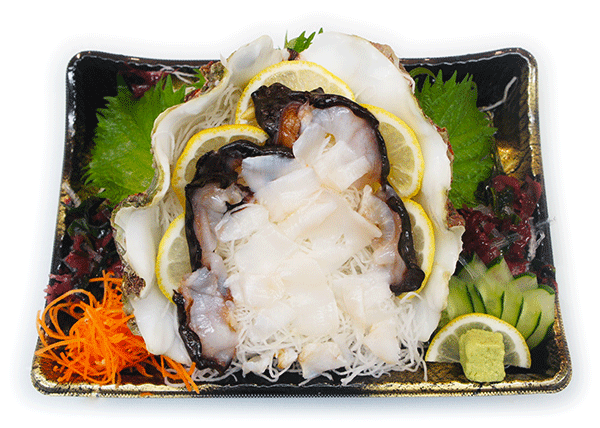
Boring clam figure sashimi
The season when shellfish tastes good in March
Spring is the time when shellfish collect nutrition for summer laying eggs, shellfish is the most delicious season in the year.
Among them, the Dolls' Festival on March 3 is the day the common orient clam sold the most in the year, and Japanese little neck also stores nutrition in the shell in the middle of March, increasing weight heavily and making it delicious, This is also the biggest sales peak in the year. Because the Japanese archipelago is long in the north and south, the seasons of shellfish are out of time due to location, but basically most shellfish will be delicious from spring to summer, no doubt.
And also generic name giant clam belonging to the Tridacninae family of the first page image also has its spawning season from June to August, so in the Okinawa district where giant clam is acquired, as can be understood from this period as a prohibited fishing period, giant clam is a delicious season from March to May with nutrition for laying eggs.
Giant clam has been used not only for everyday but also thick and large seashells as valuable treasure alongside coral as one of Seven Treasures in Buddhism and has been used for various processed items. For this reason, giant clam fellows (Tridacnidae) including giant clam and boring clam are overworked in various places, all 11 types are now listed in Appendix II of the Washington Convention, international trade is restricted.
For example, giant clam seems to have grown to about 2 m in length and weighing up to 200 kg, and it is the largest shell in the earth. Giant clam lives in shallow waters of the warm water depth in the South Pacific Ocean and the Indian Ocean, and after birth it will swim in plankton looking for an appropriate habitat, swimming for about 1 to 2 weeks to become established a coral reef, It will never move there until it dies.
Giant clam not only filters seawater inhaled using a water tube and eats plankton but also consumes sugar and protein produced by billions of algae (larval algae) that are attached and coexisting within your organization alive. Instead, spread the shell with wavy grooves in the daytime under the sea surface, further expose the outer mantle membranes of various colors, giving the algae the opportunity to perform photosynthesis by sunbathing. Because they have symbiotic relationships with such algae by their own power, they are called "living creatures with their own fields".
The mantle membrane is a cultivation room of algae, there are many eyes on the surface of the water tube, it has the function of adjusting the light quantity and wavelength of light and delivering light to the algae. The dependence on nutrition produced by this algae is about half, and it is said that it is "shellfish that eats light" because it is well alive without plankton if there is abundant sunlight.
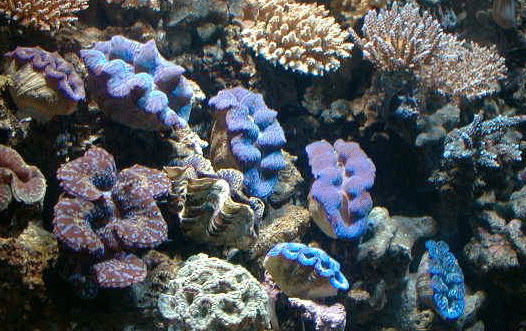
As in the above underwater image, there are considerable variations in the colors of giant clam's mantle membranes, but there seems to be no relationship between that color and the seed. This color reflects the color of the body of giant clam itself to light, and is also the color by symbiotic dinoflagellates. Dinoflagellates have chlorophyll, β-carotene, xanthophyll, etc. as photosynthetic pigments, and they seem to be yellowish brown or dark brown in color.
Not only these color combinations, but also the color of the structure color are also affected. Structural color is the color that light interferes with a specific fine structure, visible by the light coming into the eye, and the color tone changes depending on the angle. As a familiar example, there is a rainbow color on the memory side of the CD, and metallic colors of the bamboo shoots are also colored by the structural color in the example of living things.
The structural color of giant clam is formed by the microstructure of the protein present in the mantle membrane, and this protein itself is not so colorful, but it seems that when visible light hits, it seems that a vivid color appears. For this reason, the mantle membranes of giant clam that comes out from the water and looks on land is not a brilliant color in the water, but the surface of the muscle is only a dark color familiar with abalone etc.
In addition, the mantle membrane of giant clam varies in shape and size depending on the type of shellfish, but the common role is the formation of shells. On the outermost part of the mantle membrane there is a secretory tissue to make the shell, the shell grows bigger and bigger over time and grows into a shell with 2m huge shells.
Giant clam sometimes says "cannibalised shellfish", but for the reasons we have explained so far, giant clam never eats anything with two shells. In addition, the large giant clam has a slight difference in the amount of growth of the two shells so that the engagement is not perfect, and the outer shell is also huge and thick, so even if you try to close the shell, yourself gets in the way It seems that it can not be closed completely.
The picture below is a well-known Botticelli's "Birth of Venus" is a Venus statue standing on a huge shell. The shellfish drawn by Botticelli is probably like a scallop, but there is no scallop that grows so large, and if this is giant clam, I want to think that "this size is also possible".
It is not a picture as a fact but a picture drawn as an image, so whatever it is to interpret this is human's arbitrariness, so I imagine giant clam when I see the big shell of this picture. I definitely want to think that Botticelli also modeled the scallops as a model while imagining giant clam.

Dismantling of giant clam
Well, so far, I have not treated giant clam so much, but I have experienced cooking several times, but since I have eaten boring clam again and again, based on experience at that time Let's concretely write about giant clam below.
One of the cooking experiences is the following image.
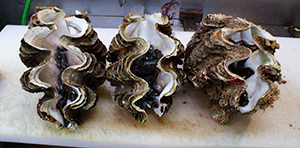
Since the width of the chopping board should be 1,500 mm, I think that it can be imagined that these giant clams are as large as several kg.
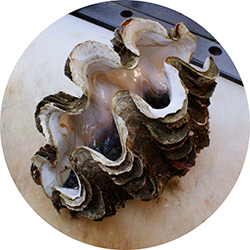
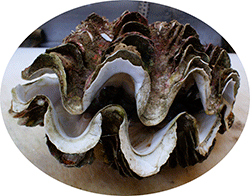
It can be confirmed that the mantle membrane sticks to the inside of the shell. It seems that it appears largely outside the shell in the water, but on the land it hides the mantle membranes in the shell.

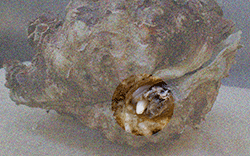
The left is the appearance of radial rib and the white part on the right is a bundle of threads that fixes the shell to the coral.
I tried to find out what species this giant clam is. Probably I guessed it was either "Tridacna" or "Tridacna noae", but judging from the size and number of fillets it will be Tridacna noae.
The image below is a large shell extracted using kaiokoshi 's tool, adductor muscle, and mantle membrane, each part.
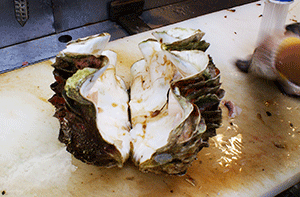
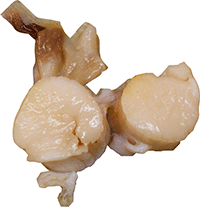

It is too big to do figure sashimi of shellfish using shell, so we made sashimi only with adductor muscle and mantle membrane. However, it was poorly completed because of its size, so let's not disclose the image.
In the Nansei Islands and Okinawa areas, giant clam shells are sold at thousands of yen to tens of thousands of yen mainly at souvenir shops and the like like the above image. However, it is very heavy that it is bigger than 10,000 yen, so it is hard to transport.
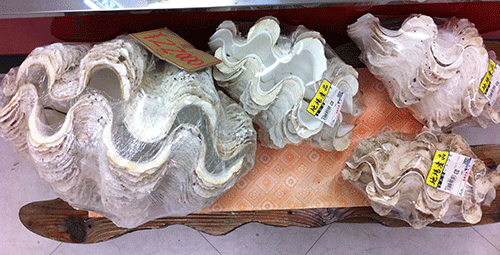
Boring clam figure sashimi
In order to sashimi giant clam, figure sashimi which made use of the shell is also good, but for that reason shelf of moderate size is required. For figure sashimi, it is preferable that the shell length stay within the range of 10 cm to 20 cm. Suitable for figure sashimi is a boring clam of a relatively small variety of the image below.
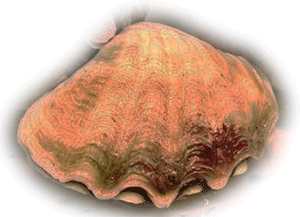
The following image is figure sashimi using the boring clam shell provided at a tavern in Okinawa.
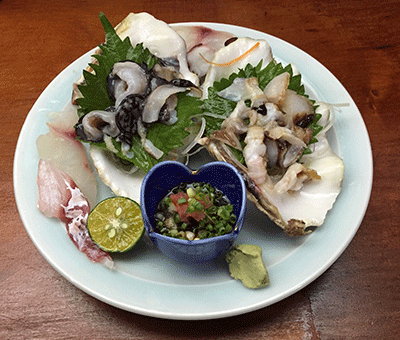
Although it was a boring clam of 10 cm or less, even with this size, the flavor of the beach could be tasted firmly.
In Okinawa, boring clam cultivation is being carried out, seedlings grown to about 10 mm seem to be grown to harvest sizes of 8 cm or more over 3 to 5 years. The boring clam served with this tavern probably seemed to be cultured.
In order to serve a boring clam with sashimi at tavern, such dishes may be served, but if you are packing in a tray in a retail store and putting it in a sales floor, you have to make a different idea.
Two years ago the author had the opportunity to cook about 15 cm of boring clam so we decided to make a figure using the shell and tried to make the following way apart from the first page image. Basically it is a way to spread both bivalves without cutting the ligaments, to show the inside of the shells to serve as a supporter.
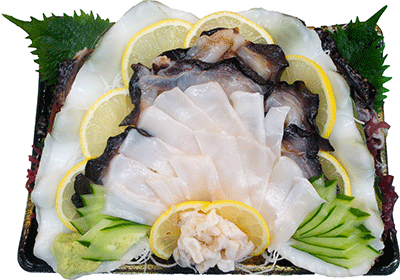
The part to eat is mainly adductor muscle and mantle membrane. I arranged the white color adductor muscle inside the black color mantle membranes, so that the adductor muscle stands out. The chopped part on the lemon is the part of the foot that is not shaped as the size of the sashimi.
By the way, I would like to mention a little about the huge shellfish inhabited by the same Okinawa and Nansei Islands coral reef.
The lower image is a turban shell with a weight of 2 kg, which is a figure made by a writer in November 2007.

The Great green turban is a kind of snail shell like the turban shell, so the part to eat is just bigger and the turban shell is bigger, it is no doubt if you think that it is almost similar.
I will take a look at Great Green turban as it is covered in FISH FOOD TIIMES Heisei era March issue No. 87. I decided to mention the Great Green turban here because the Great Green turban has male and female so when the female releases a green egg, the other male releases the white sperm and carries out reproductive activities. Actually, I want to tell you that giant clam is "hermaphrodites".
Interestingly, giant clam is hermaphrodites, holding both sperm and ovum and releasing sperm and ovum from the same individual in a manner synchronizing the time with other giant clams, so that their sperm and ovum do not fertilize First, put out the sperm, and then spawning.
Restoration of live shells
Well, I wrote about giant clam so far, but I think a little understand that giant clam is a shell that has a very unique and interesting ecology.
Not only giant clam but also shellfish will be delicious generally in the spring, so I would like you to sell shellfish firmly at this time. However, if you become a living shellfish to eat with sashimi or sushi, this is usually quite high hurdle and can not be easily handled normally.
Even though you can handle living shellfish in a sushi restaurant, Japanese restaurant, tavern, etc., you can always deal with it at a super fish store at this time and it is limited to only a few high quality shops. Being able to stock live shells themselves is an era in which this leads to the status of super fish shops.
In other words, even now abalone or turban shel has never handled with live shells, fishery personnel who do not know how to commercialize to sashimi or sushi are not so rare, more much giant clam and great green turban, It is no wonder that it is said that you have never seen or heard anything.
Because it is such an era, we want you to actively work on the assortment of live shellfish, and make this a weapon of differentiation that other shops do not have, so that I can attract customers.
Shellfishes are generally seen as being inferior in cost performance, as the content of edible parts is smaller than its size. However, shellfish sashimi and sushi, which are supposed to be alive, have special things not found in other fish.
The shop where the living shellfishes are always stocked is also a proof of being a "high quallity shop" by itself. I certainly want your store to aim for "stores that stock a living shellfish".
An opinion and the communication are to iinfo@fish food times
Date of updating 1 Mar. 2018
